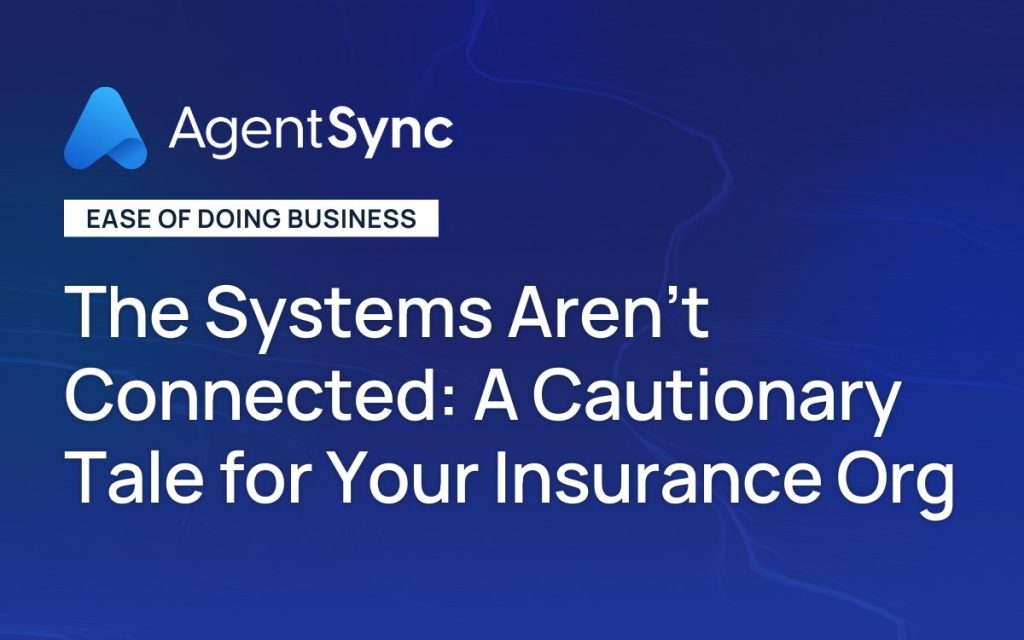The Systems Aren’t Connected: A Cautionary Tale for Your Insurance Org

We talk a lot on this blog about the trouble with data silos, the pain of manual data entry (and re-entry), and how frustrating it is for producers, employees, and business partners to constantly deal with these issues.
In case our prior arguments haven’t been convincing, I want to tell you a story that would appear, on the surface, to have nothing to do with insurance or your insurance business. Just humor me for a minute though, and I think you’ll understand how it relates.
Almost two years ago, I moved houses. Never a fun endeavor, but I’ve moved at least a dozen times in my life and it’s never been this bad. It wasn’t the fact that the moving truck ran into our powerline and knocked out the internet for a week. Nor was it that our new neighbors soon proved to be busybodies who’d voice their every complaint about lawn maintenance to the county authorities.
It was the mail. The change of address forms to be exact.
The problem is twofold:
First, we moved to a rural area where the Postal Service doesn’t deliver mail to the physical house address. If something doesn’t have our P.O. Box number on it, forget about it. Because the post office doesn’t have an easy, quick, and automated way for our address to be connected to our box number, the staff just flat-out refuse to do the work of redirecting our mail into our box.
This means anything addressed to the home itself gets returned to the sender as undeliverable. If you try to imagine the number of important things we don’t receive because someone had our physical address and not our P.O. Box, multiply it by 100 and you might be close.
Second, despite filing change of address forms (and yes, including listing the P.O. Box number) with everyone from the Postal Service, to the IRS, to the state department of revenue, to the department of motor vehicles, to the county treasurer, county tax assessor’s office, and more, mail is still sent to our old address – or sometimes sent to our new address but without the box number, meaning it’s equally undeliverable.
Last time I got a piece of mail that finally made it to me thanks to the very kind new homeowners of my previous residence, I called the government entity to correct the address (again). I was really at my wit’s end with the poor lady on the phone who had to listen to me rant about all the times, and all the places, I’ve already filled out my new address over the last 18 months.
“How is it possible that you still have the wrong address for me?” I begged to know.
“I’m sorry. It’s just, the systems aren’t connected.”
It was at this point I realized there was a very large disconnect between my expectations as a consumer and the technological capabilities of every government agency I have to interact with as a citizen.
Are you starting to see the similarities between my tale of woe and what your staff, producers, or insurance distribution partners may be going through? Just to be super clear, let’s break it down:
Manual-only processes: It’s possible that the people in charge of producer license compliance at your organization are tasked with some crazy-manual processes. Like cross referencing between paper documents, spreadsheets, and websites. It’s possible that they have to re-check things on a regular basis because there’s no real-time way to instantly verify a producer’s license status.
All of this means it’s possible, just like my local postal workers, that they simply opt-out of doing some manual work, or let things slide, or just don’t have time in their day to get to it. Even if everyone is taking the time to diligently work through these manual processes, they’re still error-prone, so you likely end up with less-than-ideal levels of accuracy. Like the time someone transposed the numbers for my P.O. Box and accidentally gave someone else a box of live wasp larvae intended to control the fly population on my farm.
Multiple, disparate systems: If you’re an insurance carrier that contracts with many different agencies (or other intermediaries), or an insurance agency or MGA/MGU that contracts with lots of different producers, it’s almost guaranteed that someone along your insurance distribution channel is entering the same information into more than one place. In fact, they’re probably entering the same information into more than two or three places. Not only is this frustrating for everyone involved, but it can lead to errors and oversights that could put your organization into compliance hot water.
No single source of truth: Imagine the frustration of a licensed producer who’s trying to update or correct some piece of information. Maybe it’s a new non-resident state license, or maybe they just passed a licensing exam for a new line of authority. How many different places do they have to enter this information? Depending on what it is, they could have to go to your company’s human resources information system (HRIS), your agency management system (AMS), your customer relationship management system (CRM), your incentive compensation management system (ICM), their state department of insurance, and other regulatory bodies – just to name a few! And, since we don’t know what we don’t know, they’ll continue to play whack-a-mole with incorrect information for as long as it takes for each location housing that information to surface.
Now, imagine, if that’s how it is for one single producer, what it must be like for anyone in the distribution channel who’s tasked with managing information for multiple producers. Do you have a headache yet?
To sum it up, the price you pay for sticking with manual, labor-intensive processes may include:
- Data that’s out of date as soon as you check it
- Frustrated employees, producers, and distribution partners
- Risk of compliance and regulatory mishaps
- Losing the best people to an organization that makes their jobs easy and painless
The great news is that AgentSync can help eliminate these issues for your insurance organization and its partners. On my end, I’ve got no choice but to fill out forms for the umpteenth time and pray that the day will come when everyone who needs my address has the right one. You don’t know how much I’d give to have a solution at my fingertips that could make this problem disappear quicker than my ever-shortening patience.
So, for all the people who don’t have a solution to the problems of data silos, manual processes, and outdated technology wherever these may creep up in life, don’t you owe it to yourself to check out AgentSync?

